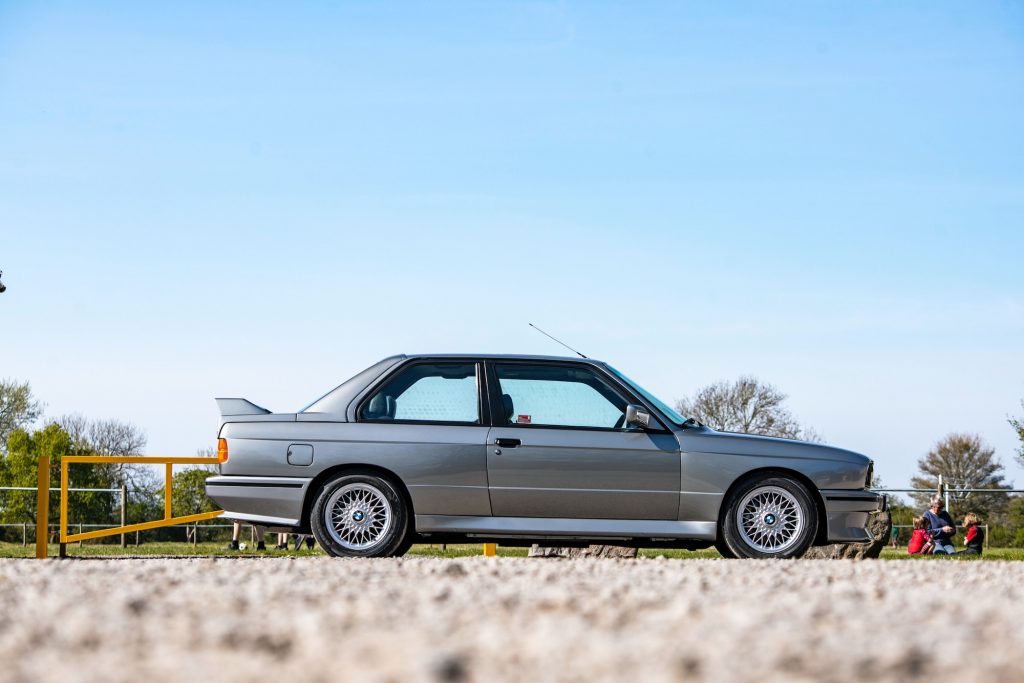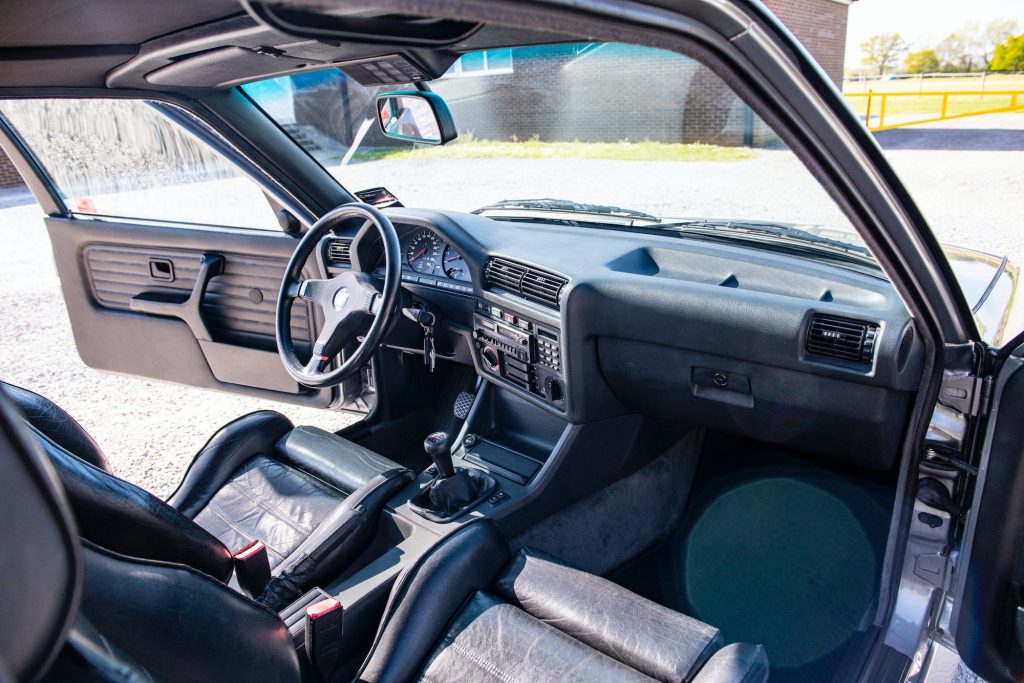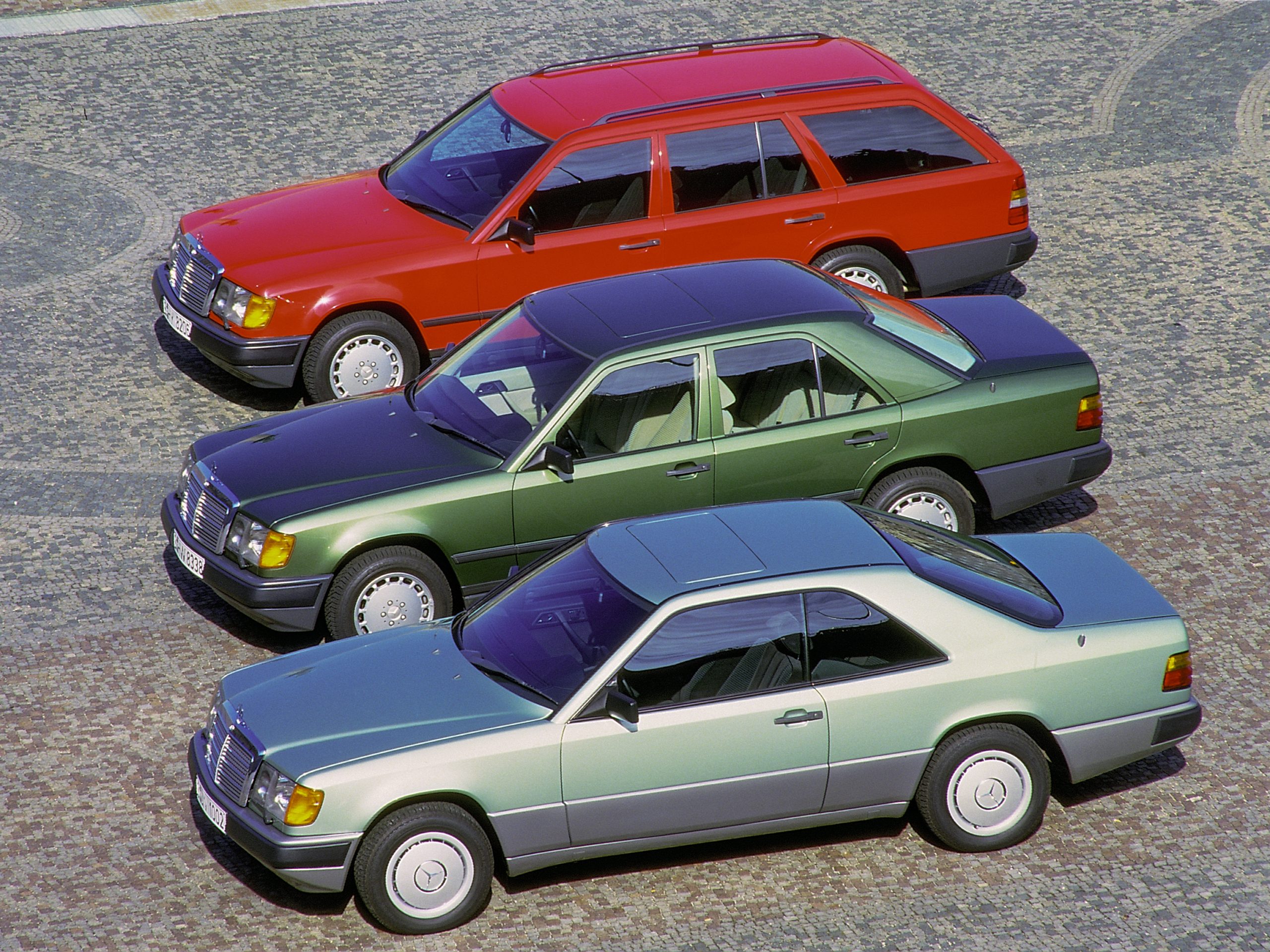Many homologation cars have required some deft counting by their makers to meet the minimum requirement of road cars in order to go racing. BMW had no such worries with its original M3, based on the second-generation 3-series, known as the E30. By the time production ended, some 17,970 had been sold – and the M3 badge had become one of the most coveted in car enthusiast circles.
The German car maker had originally planned to make 5000 E30 M3s to qualify the car for the European Touring Car Championship. BMW had endured the ignominy of being beaten by arch rival Mercedes in this high profile series and the E30 M3 was its riposte.

Far from being a warmed-over two-door 3-series, the M3 was a bespoke car with unique engine and bodywork. One of the most obvious changes to create the M3 was its blistered wheelarches. This allowed for a wider track and revised suspension, which made use of 5 Series-sourced stub axles and bearings that meant the M3 had a five-stud pattern rather than the four-stud arrangement of the non-M models. There were also stiffer springs, Boge dampers, thicker anti-roll bars, and 15-inch BBS alloy wheels. Braking was courtesy of 280mm vented front discs and solid 282mm rears, with an anti-lock system as standard.
Aside from the wheelarches, the biggest change to the M3’s body was the rear screen. Wind tunnel tests showed the standard 3-series’ C pillars and back window were too upright to work with the M3’s proposed boot spoiler. The answer was to add a rear screen with a more shallow angle, which necessitated thicker rear pillars. BMW also used a bespoke bootlid, which sat higher to feed air over the rear spoiler. There were unique bumpers, too, so in the end only the bonnet and doors remained from the standard saloon. The changes meant the M3 enjoyed a drag coefficient of 0.30Cd, a substantial improvement from the normal two-door’s 0.38Cd.

However, BMW wasn’t done with turning the 3-series into the M3. Under the bonnet was a four-cylinder engine, code number S14, built specifically for homologation purposes. The four-cylinder design was chosen by BMW’s technical director Paul Rosche over a six-cylinder to save weight and improve handling, and because the six-cylinder engine from the M1 and M635CSi suffered vibrations at higher revs.
With Bosch Motronic fuel injection, the prototype engine was developed by adapting the M1’s four valves per cylinder head and was running in just 14 days, which prompted the S14 name. The block could trace its lineage back to the 2-litre unit from the BMW 1500 launched in the 1960s. With a longer stroke crankshaft and enlarged bore, the S14 had a capacity of 2302cc and made 200bhp at 6750rpm. A catalytic convertor was an option for buyers, which reduced power to 195bhp. Off the mark, these first M3s were good for 0-60mph in 6.5 seconds and 146mph, driving through a Getrag five-speed manual gearbox with first gear on a dogleg. When the M3 was launched in the US in 1988, it was fitted with a standard H-pattern five-speed manual with wider ratios but shorter differential final drive to preserve performance.
BMW introduced the Evolution model in 1987, featuring a 215bhp version of the 2.3-litre engine, which was fitted to US-bound cars in 1988. The increased power helped with homologation for racing and rallying, with 40 cars sold in France in ’87 as Tour de Corse special editions. The following year, BMW offered the Europameister edition, selling 148 and all in Macau Blue, complete with a sticker signed by Roberto Ravaglia, the racing driver, to mark winning the European Touring Car Championship. These cars should not be confused with the 25 Ravaglia editions sold in 1989 alongside 480 Cecotto Editions. For 1988, BMW introduced the M3 Convertible with the 195bhp engine, while the 220bhp Evolution II arrived with coupé body.
The Convertible gained the 215bhp engine in 1989, and the Cecotto and Ravaglia editions were sold in this year too. Then, in 1990, in the heat of competition on Europe’s race tracks, BMW qualified a package of aerodynamic updates and a larger capacity engine, in the shape of the Sport Evolution. It had a 2467cc engine that produced 238bhp at 7000rpm.
All have appreciated in value significantly, over the past decade. Find out what the appeal is.
What’s a BMW M3 E30 like to drive?
If M3s are widely regarded as delivering a scalpel-sharp driving experience, the E30 M3 is keyhole surgical in the way it gets under your skin. Some of this comes from a machine devoid of driver aids other than ABS anti-lock brakes, lightly assisted steering with a quicker rack than other contemporary 3-series models, even weight distribution and effective suspension design.
With modern tyres fitted, the M3 can keep up with modern fast hatches through corners, though you will notice a little body lean. This isn’t something to worry about as it’s simply a means of gauging how hard you’re pushing the car. When the rear tyres do relinquish grip, it’s in a progressive fashion that is easily countered with the quick-acting steering that lets you know exactly what’s going on. However, don’t think the rear-wheel drive set-up of the M3 makes it a drift car – this is a machine that rewards precise inputs but feel sluggish if driven without dedication.

Nowhere is this divisive nature of the M3 more obvious than the engine. With peak power arriving at 6750rpm or higher still with the Evo Sport model, you have to be prepared to work it hard through every one of the gears. With relatively little torque to compensate at lower revs – 177lbs/ft at 4750rpm – the generous capacity of the BMW’s four-cylinder engine does not mean you can pootle in a high gear at low speeds. Compared to a Porsche 944 or 968, the BMW is a busier, less relaxing car when it comes to getting the best from it.
If you’re prepared to make that commitment to the M3, and plenty are, the S14 engine is a joy to use. Standard cars will rev to 8000rpm when in good health, and it’s easy to free that up to 9000rpm safely if tuning the engine. The caveat here is you must let the engine fully warm up before working it hard. This also applies to the gearbox, which can feel quite stiff and slow-shifting until its oil is up to operating temperature, when it offers an accurate but not particularly fast action.
However, the M3’s engine, gearbox, steering, brakes, and suspension are all far better than most cars of the mid-1980s. The suspension is also supple enough for longer drives as it has more give than most current performance cars. Also, unless you are using all of the revs all of the time, the E30 M3 is a surprisingly refined long-distance tourer with good all-round vision, decent boot, and space for two passengers in the back.
How much does a BMW M3 E30 cost?

Thanks to its impeccable credentials as a road, race and rally car, the E30 M3 has increased considerably in value over recent years. Many collectors who grew up watching these cars race and dreamed of owning the road-going equivalent now regard it as an essential in their garages, which has further upped the desirability and prices of the very best cars. However, you can still find a fair condition example from around £35,000 according to the Hagerty Valuation Tool. Look for one of the standard 200bhp or 215bhp models in perfect, concours condition and that price will double to £70,000.
For those who want a rarer version of the E30 M3, deeper pockets are required. A convertible is presently valued around £82,000 for a perfect specimen, or £43,000 for one that you can use and enjoy while improving at the same time. Opt for an Evo or Evo II and £95,000 is the price of ownership for the very best or £55,000 for one in good nick.
The M3 Sport Evolution is the ultimate in the line-up and comes with a commensurate price. Find a pearl and you can reckon on spending as much as £160,000, or around half that for one that’s usable but needs plenty of work to bring it up to a high standard.
What goes wrong and what should you look for when buying a M3?

The E30 M3 is a robust car where little goes wrong so long as the car has benefitted from routine maintenance and tasks that and aimed at preventing problems further down the road. There was a period where these M3 were cheap enough to be disposable track day toys or modified with little regard to the original ethos of the car. Many of these cars have been scrapped due to rust, but you still need to be on your guard for anything that has been given fresh paint in a bid to cover up what lurks beneath. BMW specialists can be your friend here; some even perform a free inspection as they set out to establish a relationship with a new client.
Look for corrosion everywhere as the base E30 3-series is susceptible to rot and the M3 follows suit. Lift the carpets and inspect the whole floor in the cabin and boot, and look all around the windows and, if fitted, the sunroof. Check the underside of the car in every nook and cranny, and also the engine bay for the suspension turrets and chassis legs. While underneath the car, see if the subframe has any cracks that point to collision damage, and then pay attention to the inner edges of the wheelarches and bottom of the doors. Also, look at the fuse box cover; if it’s cracked, there’s a good chance the car has been driven hard on track.

Inside, the M3’s interior is durable, but seats will wear and some fabric is hard to source for the less common trims. Check the dash display works and the service indicator is doing its job, but don’t be surprised if the suede steering wheel is worn smooth.
Standard wheels are desirable, while larger ones can rub on the arches. The brakes are strong and easy to service, but the hand brake is a known weak point so be sure it holds the car on a hill. Unless there’s evidence the suspension bushes have been replaced recently, you can expect to change these but it’s not a tricky job. Rear shock absorber mounts can fail, and worn front tie-rod ends will be felt as a judder when braking.
As for the S14 engine, it’s very durable but look for leaks from the sump and make sure the oil level is correct. Any roughness at idle is likely to be incorrect valve clearances, though split rubber intake gaskets can also cause this symptom. BMW recommends changing the cam chain at 100,000 miles, but given few cars cover this mileage now, reckon on doing this job every five years. Lastly, look for any leaks from the differential or gearbox.
Which is the right M3 for you?

Modern classic cars don’t come much more sought after and revered than the original BMW M3. But which version to choose, if you’re in the market for one? There’s not a great deal of difference in performance between the least powerful 195bhp E30 M3 and the all-singing 238bhp Evo Sport. On track, the more potent models have the edge, but on the road the E30 M3 is much more about its superb handling balance. As such, a well sorted 200- or 215bhp model is the one to choose if you intend to drive the car regularly rather than set it aside as a collector car, especially when factoring in pragmatic matters such as budget.
The special edition models are no quicker than the other M3s of the period, so it’s mainly rarity that increases their appeal. For some drivers, a bigger question is whether you choose the convertible over the saloon, or coupé as some call it. Our preference is the saloon as there are more to choose from and it doesn’t have the slight scuttle shake found in the open-top M3.
BMW didn’t offer the E30 M3 in right-hand drive, so you will need to be happy with driving a left-hooker on UK roads. A tiny number of cars were converted to right-hand drive in period by Birds UK, which was officially approved by BMW to perform the work. If you can’t find one of these cars, it is possible to convert a left-hand drive car to put the steering wheel on the right, though you would have to consider the impact on the car’s future value versus your enjoyment in the here and now.
Read more
Executive Decision: Audi 80 vs BMW 3-series vs Mercedes 190E
Driver error: Buying a BMW M3 E30 on reputation alone was madness
The Ones That Got Away: Vicki Butler-Henderson’s BMW M3 CSL and Golf GTI 16v

















